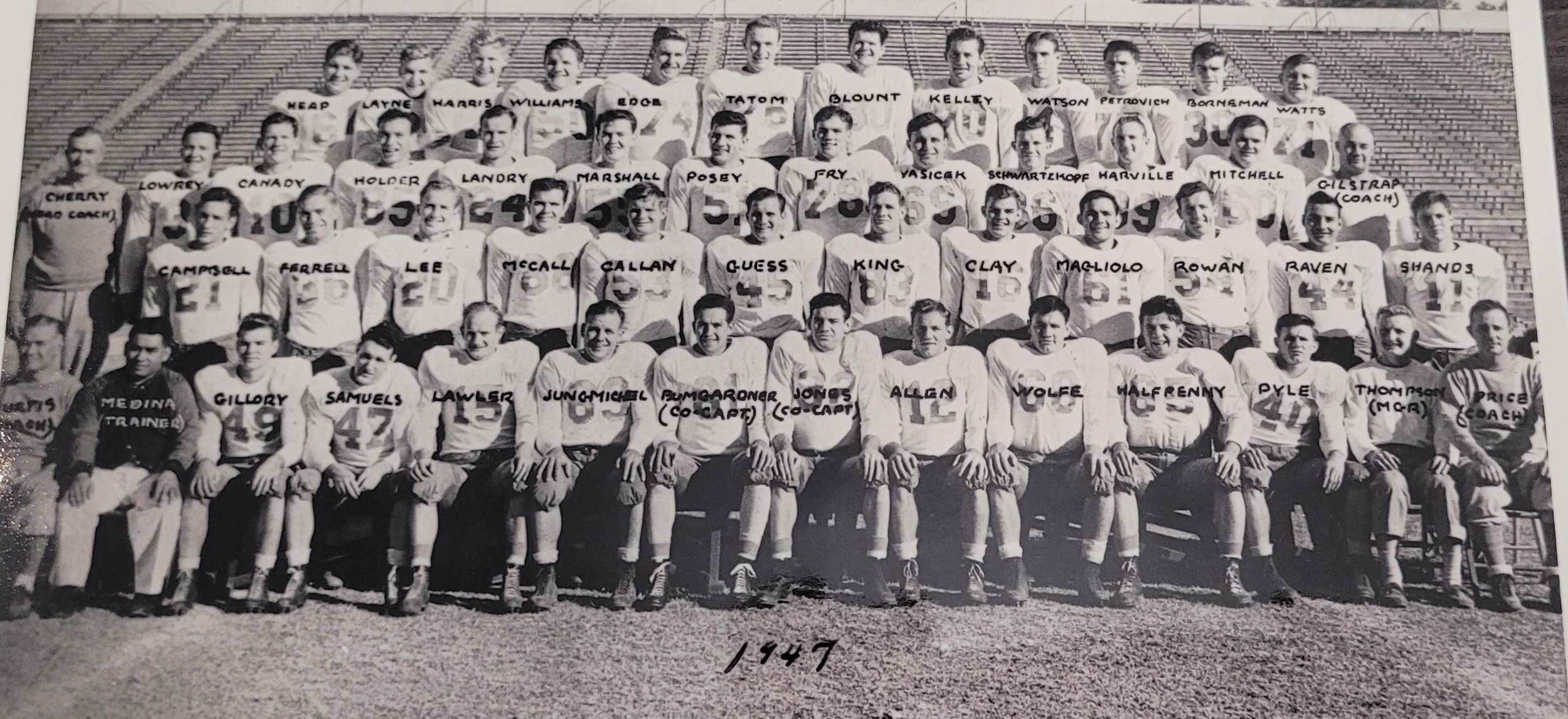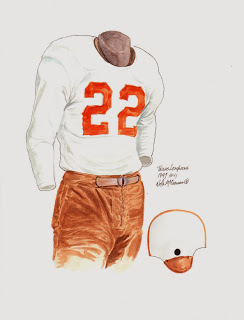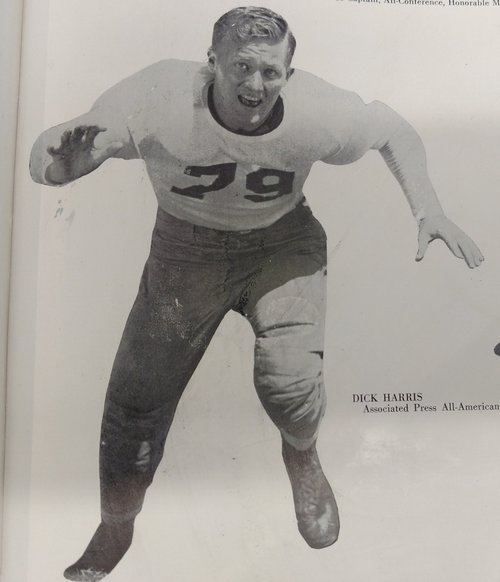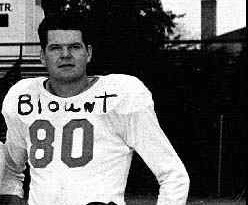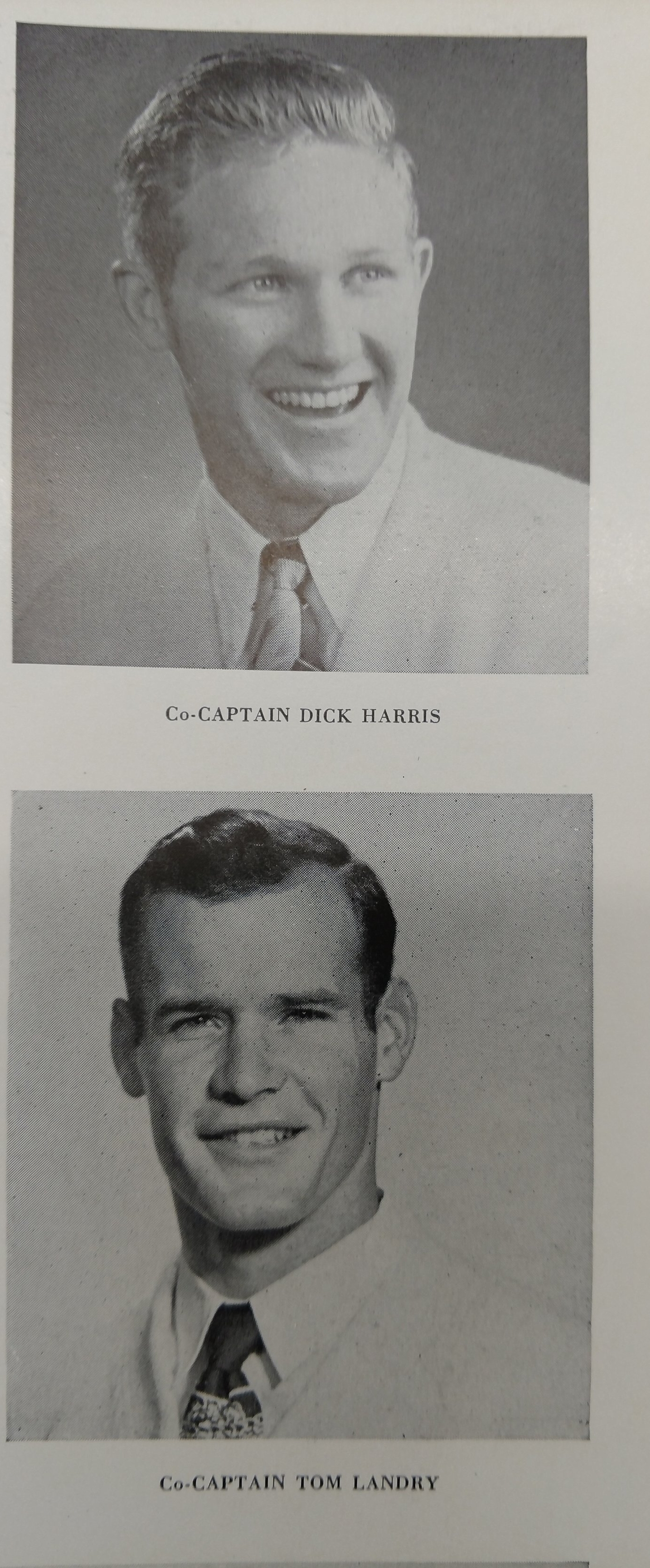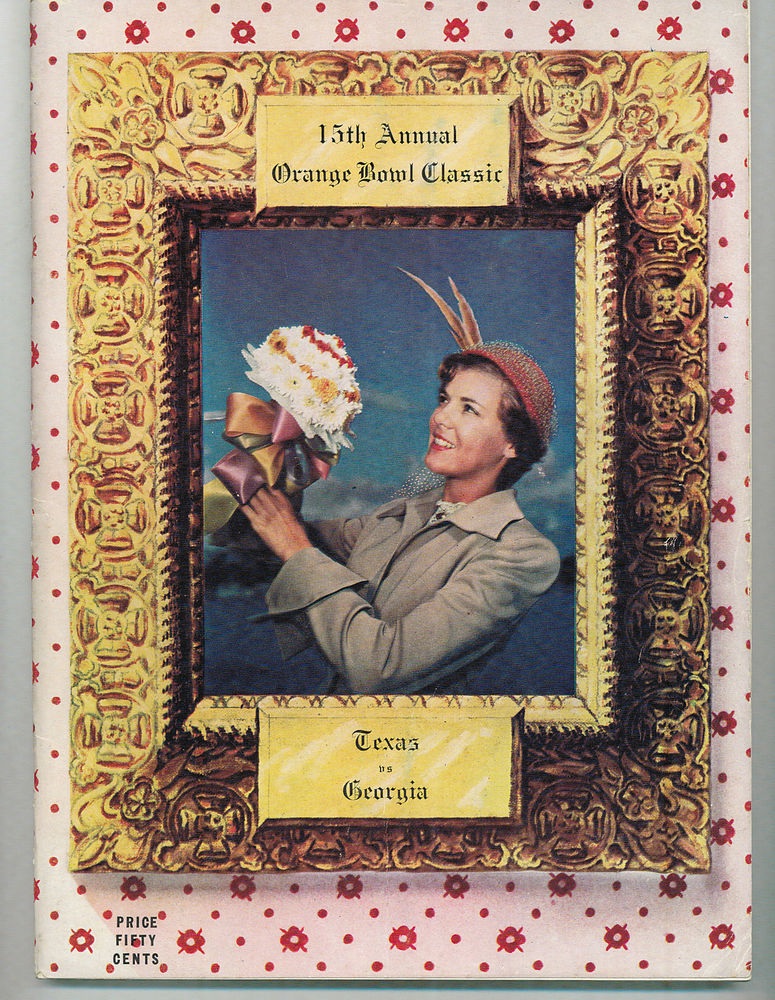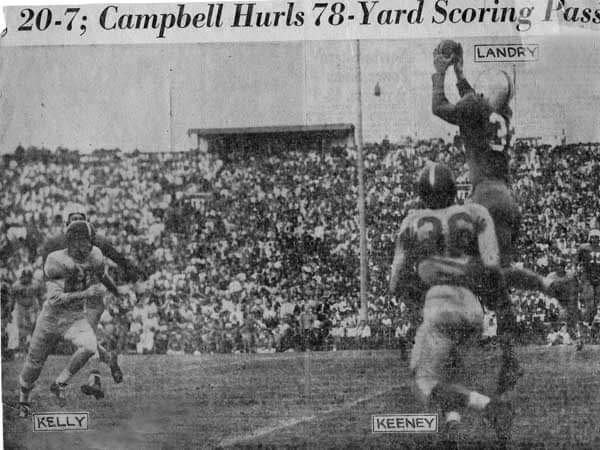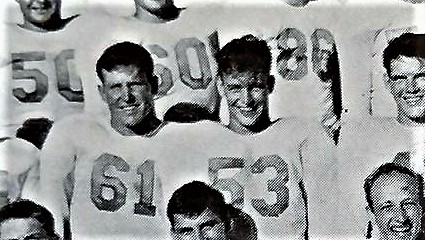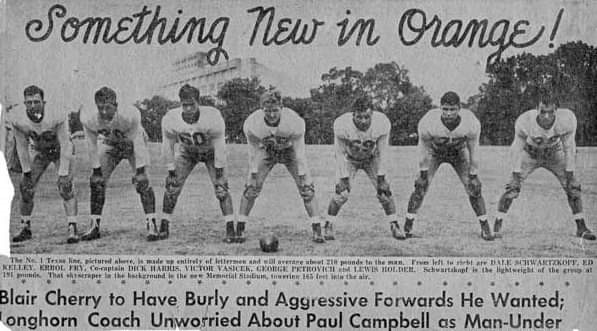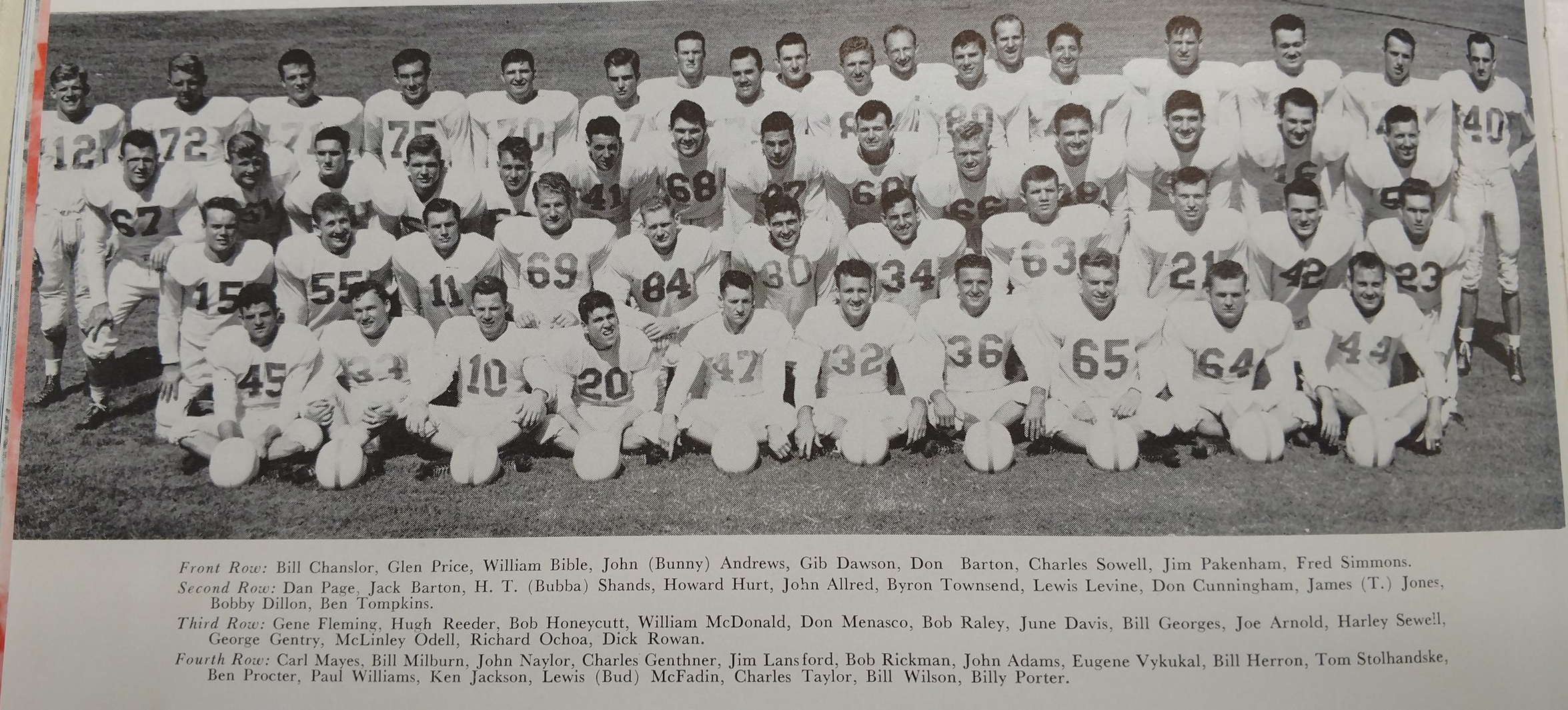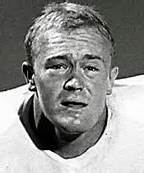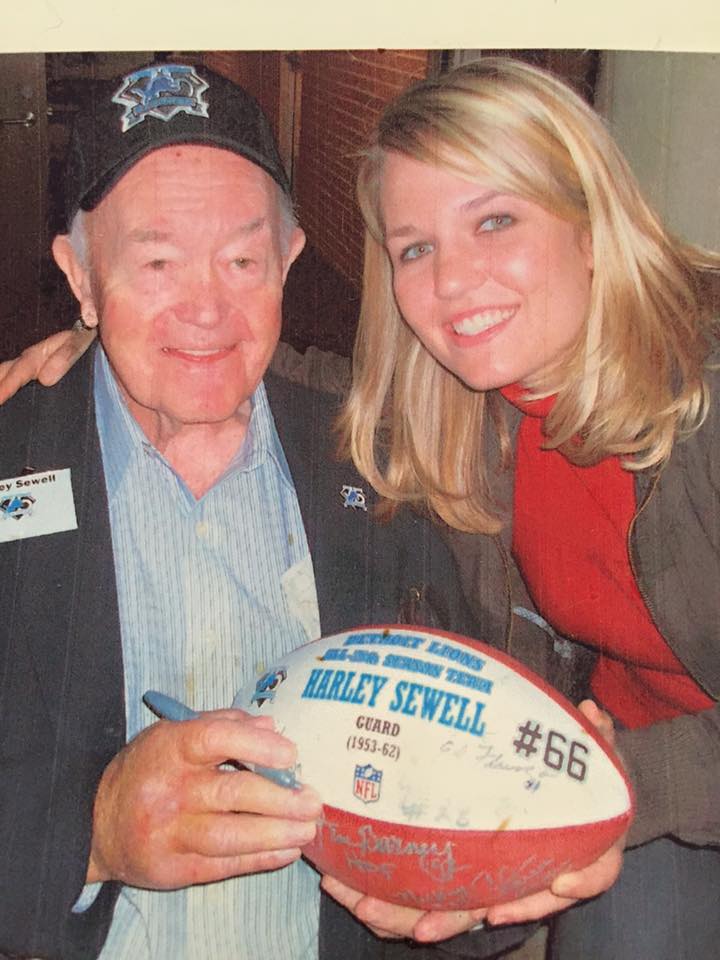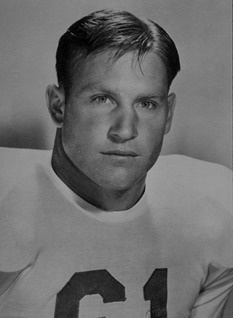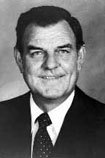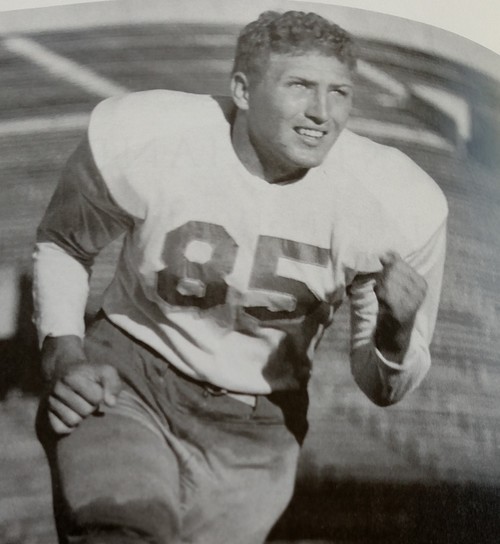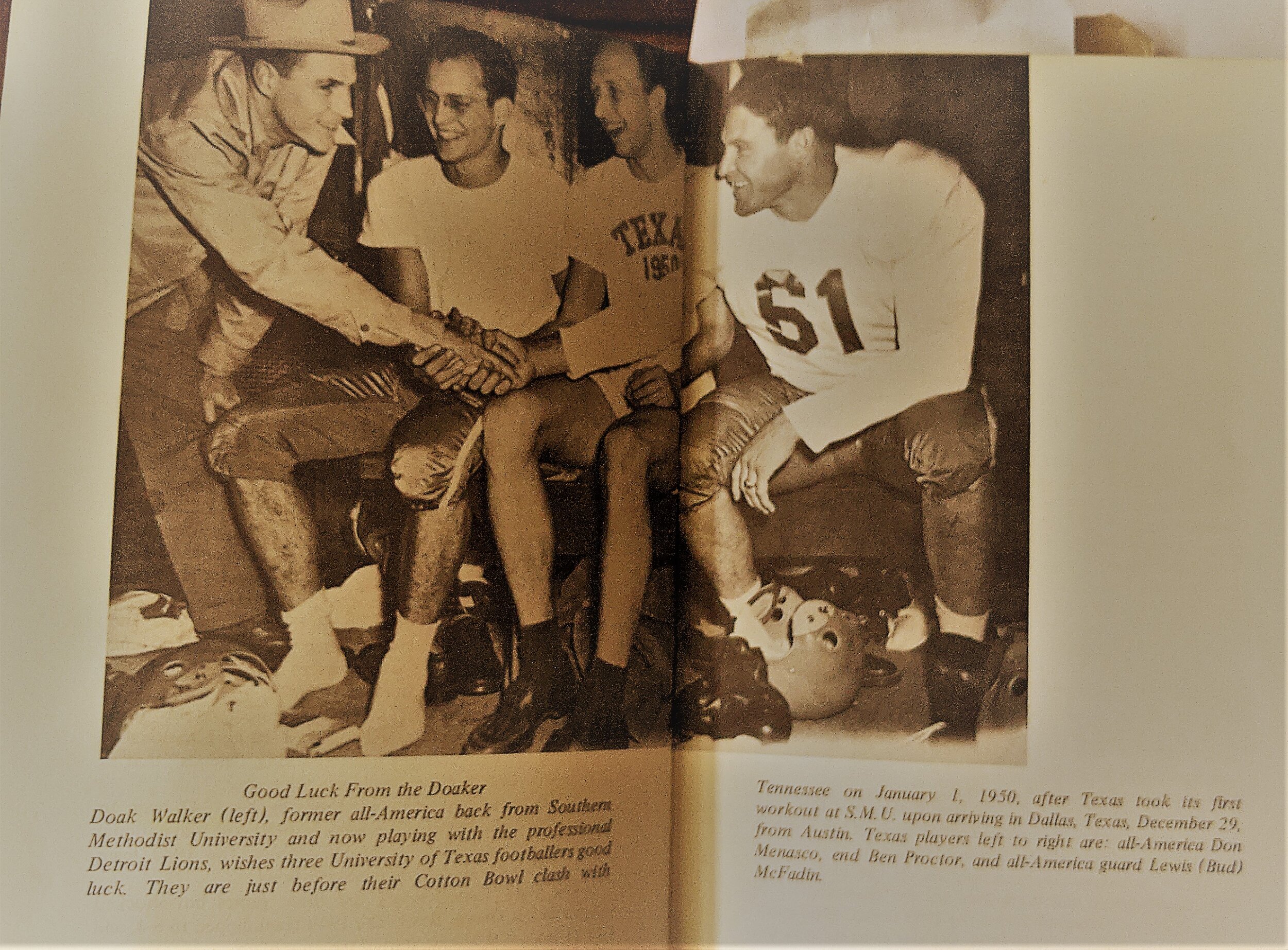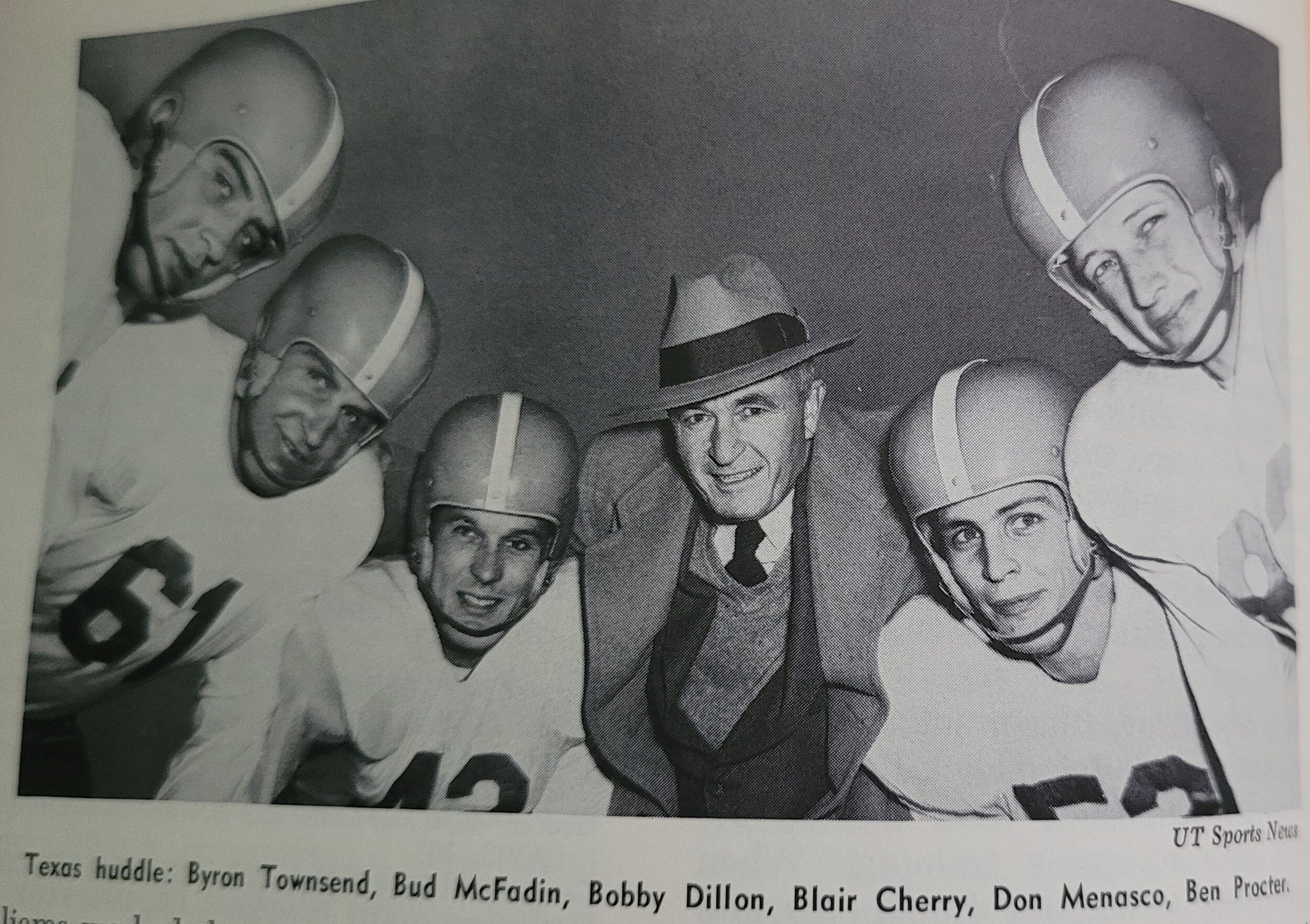In the Book Forty-acres Follies, the author Joe Frantz says about Coach Cherry, “In character Cherry was the antithesis of Bible.” While Bible was a schemer and a motivator, talkative and charming, Cherry was moody, quiet, and difficult to know. Cherry never got along easily with the press or alumni, while Bible knew how to work both.
But what he lacked in PR skills, he made up for in football IQ. He Cherry knew how to position players and get as much out of them as they had. It was Cherry who moved Bobby Layne from running back to quarterback. A brilliant move that almost resulted in a national championship, except for one fluke play that cost the Horns the game against SMU.
His teams included All-American Bobby Layne, Dick Harris, Bud McFadin, Randy Clay, Don Menasco, and Bobby Dillon.
1947- 1950 Coach Blair Cherry Leads The Postwar Era
BLAIR CHERRY. Cherry won three state titles at Amarillo High. He joined the staff of Dana X. Bible at UT and later became head coach at UT for the 1947 through 1950 seasons. The 1947 team, with Bobby Layne at QB, ended up ranked No. 5 in the AP poll, and the 1950 team was No. 3 in the AP and No. 2 in the Coach's poll.
But like Longhorn coaches before him, mean-spirited fans led to him developing ulcers and insomnia, so he resigned in 1950.
Like Coach Akers, Coach Cherry almost won two national championships in 1947 and 1950 but lost to SMU in 1947 by one point, and Cherry’s inability to beat OU caused a fan revolt that resulted in his resignation.
1947 10-1 COACH BLAIR CHERRY team Ranked 5th nationally
1947- l ro r- Medina, Emerson, Gilstrap, DuBose, Jungmichel, Curtis, King, and Price
Coach Cherry was the first coach of the Longhorns that was born in the state of Texas.
Returning servicemen swelled Texas enrollment to 17,344 students. 15 lettermen returned from former seasons returned and joined the team raising the letterman total to 32.
Coach Blair Cherry changed the Longhorn offense to exploit Bobby’s strengths. Layne moving him from the single-wing tailback to the T formation quarterback. Longhorn's history proves that was the right decision.
1968 was the year of the purge and the new Wishbone offense. DKR’s job after three 6-4 seasons was in jeopardy, so he decided to challenge the player’s resolve to play football. Many quit the team in the Spring of 1968 and during two-a-days in the Fall.
In 1947 there was also a purge and a new T- formation offense. Work-outs were rough. Cherry believed in more drills and fewer lectures. He ran the team hard and allowed no water which was a common practice of that day. Player’s who passed out were revived by Frank Medina with a cold towel. The hard work paid dividends just like it did in 1968.
Texas travels by air for the first time to play Oregon. Bobby Layne out dueled Oregon’s Norm Van Brocklin 38-13.
Layne becomes Texas's first 4 times all SWC player.
Ed Kelly literally loses his pants in the Arkansas game.
Riddell football helmets were introduced to Texas.
The Longhorns, after beating #19 North Carolina, started the season ranked third. They then beat #15 Oklahoma, but as happened in 1945, Texas was again denied an undefeated season by a missed extra point. After coming back once against Walker's number-8 SMU, Texas again found itself behind late in the game.
Only loss in 1947 was to SMU. Layne, Bumgardner, and Dick Harris are unanimous All SWC. This team won all of their games convincingly but Texas was never able to recover from two early strikes for touchdowns by SMU.
In author and former Longhorn football player R.E. Peppy Blount book titled Mamas, don’t let your babies grow to play Football, Blount says that Cherry was a master tactician.
Layne’s backfield sported another future NFL Hall of Famer: fullback Tom Landry.
Prior to the Texas A & M game Coach Cherry has an emergency appendectomy surgery, and he does not attend the game.
most popular song 1947
Final ranking 5th nationally
This Team's Defense Holds The Longhorn Record For Fewest plays allowed by the opposing team (26).
1947 team is recognized as national champion by some national rating services but not recognized by Texas or the NCAA.
The “Sisco Game” - THE BATTLE OF THE BOTTLES
Here is part of an article written by John Nova Lomax for the Texas Monthly in Oct. of 2017 about the Texas - OU game of 1947 titled Let’s Hope This Year’s TX-OU Game Doesn’t Repeat the 1947 Game
It is no exaggeration to say that were it not for the swift, firm, and violent actions of the Dallas Police Department in the aftermath of the 1947 game, one or more of the officials might have been killed by enraged Sooner fans.
Blair Cherry’s Horns were ranked third in the nation. Swashbuckling quarterback Bobby Layne led the burnt orange attack with both his legs and, unusually for the time in that run-heavy era, also his arm.
With the soon-to-be-legendary coach Bud Wilkinson stalking the sidelines, fifteenth-ranked Oklahoma’s offense was led by speedy QB Jack Mitchell, its defense anchored by ball-hawking back Darrell Royal, who, like Landry, doubled on offense and tripled on special teams.
Texas marched down the field to the Oklahoma two, where the drive stalled. With twenty seconds left on the clock, Longhorn back Randall Clay managed only one yard. The Horns hastily lined up and Clay got the call one more time. In spite of the fact that the Sooners stuffed Clay for no gain, referee Jack Sisco threw his hands in the air, signaling a touchdown. Once the dog pile was untangled, it became clear to all 50,000 fans—and Sisco—that Clay had not scored. The ref negated the touchdown, but Sisco claimed that someone in the pile had signaled for a timeout with three seconds left on the clock he had in his hand.
Sisco later explained that because he had initially signaled a touchdown, he didn’t have time to signal to the stadium’s clock operator that a timeout had been called, and in those days, referees did not have microphones that enabled them to explain themselves to the fans over the stadium’s PA system. At any rate, his clock showed three seconds, but the stadium clock showed zero, and OU coaches and fans had no idea why the Horns were being allowed to run one last play with no time left.
A chorus of boos rained down from the Cotton Bowl’s crimson-and-cream contingent, and those only intensified when Longhorn back Jim Canady slammed into the Sooner line and fumbled. The ball squirted backward to a kneeling Layne, who scooped it up as he rose to his feet and pitched it back to Clay, who scooted around two dumbfounded Oklahoma defenders for a touchdown. The Sooners had thought that one of Layne’s knees had been on the ground when he picked up the ball, thus rendering the play dead and the half over, but Sisco disagreed. (Back then, you had to wait a couple of days to see replays, and by Tuesday, newspapers were reporting that the game film showed that Layne had, in fact, been down when he pitched the ball to Clay.)
So it appeared the Longhorns had been awarded a free play, and then handed an illegal touchdown. Wilkinson was irate. As the teams headed toward the locker rooms, the coach dashed his fedora to the ground and barreled onto the field to give Sisco a piece of his mind, accidentally flattening a Longhorn marching band piccolo player en route. Amid Sooner boos and catcalls, the half came to a close.
Much of the third quarter proceeded without scoring or controversy, but then a Darrell Royal return of a Tom Landry punt was called back thanks to a ticky-tack clipping penalty, bringing more howls of outrage from the Sooners. Instead of starting their next drive in the relative comfort of their own 25, the Sooners found themselves pinned down at the one-yard line. A short punt ensued, and Texas took advantage of the short field to score another TD and go up 21-7.
Taking over at their own 20, the Sooners struck back on their first play from scrimmage, when Mitchell snagged a lateral from a halfback and raced 72 yards untouched to the end zone, bringing the score to 21-14 after Royal’s extra point. (There wasn’t a lot Darrell Royal didn’t do for the Sooners.)
After the kickoff, Texas took over at the 16 and quickly marched to the Oklahoma 38, where Royal—there he is again—picked off an errant Layne pass, giving the Sooners the ball and a chance to tie.
Or not. In yet another close call, Sisco flagged an OU lineman for roughing Layne, giving the ball back to the Horns at the Oklahoma 23. In the stands, Sooner rage was approaching seismic levels, and it erupted when Sisco’s crew awarded Clay a touchdown, after they let play continue long after it appeared his forward progress had been stopped at the one-yard line. That’s a second potential goal-line stand negated.
First a single soda bottle came flying down from the stands. Then a couple more. Next a hip flask or three and the odd whiskey bottle, and then a deluge of many more glass projectiles, not to mention seat cushions and anything else not bolted down. Sooners and Horns alike rushed to the middle of the field to get out of range. Fistfights rippled through the grandstands wherever Oklahomans and Texans were in proximity. Wilkinson and the Oklahoma cheerleaders urged the fans to stop the barrage to no avail—there would be no ceasefire until they ran out of ammo. Finally, Longhorn and Sooner cheerleaders cleared the debris and the game continued, with the Horns rattling off 13 unanswered points and the game going in the books as a 34-14 stomping.
By the time the whistle blew, Sooner fans had replenished their stocks and opened up a second barrage. Neither Sooner nor Longhorn was safe from the indiscriminate fusillade. Years later, Royal would remember that he had to put his helmet on the head of his future wife, Edith, and hustle her off the field to the safety of a Cotton Bowl tunnel.
Many of these players had seen more than most. And yet even they were alarmed. “A lot of us were war veterans,” remembered Landry. “But I guarantee you we were scared.”
In addition to the aerial assault, the Sooner blitzkrieg featured an infantry attack. A number of Oklahoma fans—dozens, if not hundreds—stormed the field with the aim of getting to Sisco and likely tearing him from limb from limb. “They would have killed him, if they could have gotten to him,” Oklahoma lineman Merle Dinkins said, years later.
One fan did get to Sisco, but the former football star decked him with a single punch. Just then, a Dallas police car sped on to the field and Sisco and his crew were hustled inside, moments ahead of the main body of the Sooner mob. “They were beating on the windows of that car while it left the field,” remembered OU halfback Tommy Gray. Meanwhile, nightstick-wielding Dallas cops were whacking Sooner skulls all over the glass-strewn Cotton Bowl turf, and finally, order was restored in the Cotton Bowl, if not the city of Dallas, where irate Sooners rampaged through downtown, smashing store windows and hurling furniture out of hotel rooms, injuring a few innocent bystanders along the way.
Meanwhile, in Norman, a thousand Sooners gathered in front the university’s administration building and hung an effigy of Sisco, while singing “Don’t Send My Boy to Texas.”
They had planned to burn the mock-referee once they had cut it down, but somebody stole “the body,” so they had a do-over the following night. This time, 3,000 Sooners came to watch as a new Sisco effigy was set on fire in a campus parking light. As the referee’s likeness crackled in the flames, the crowd sang “Jack Sisco’s body lies a’smoldering in the grave,” and then, as a reporter put it, “they trampled on the embers and went home.”
None of which is even the slightest bit disturbing. Nope, not at all.
Though the game is all but forgotten today, there were a few lasting effects. For a time, the verb “to Sisco” was Oklahoma vernacular for “to be swindled,” as in “I sure got Sisco’d on that leaky-roofed double-wide I bought for me and Earlene an’ ‘em.”
And the game changed the nationwide fan experience in a small way: In the aftermath, the Cotton Bowl banned glass bottles, a move that was nearly universally emulated across all American sports. (Keep in mind, this was before plastics had become ubiquitous, so it ushered in the era of flimsy paper cups.)
Though there was some talk of suspending the Red River Shootout in the aftermath of this game, athletic directors from Texas and Oklahoma nipped that notion in the bud. In retrospect, Texas probably wished they had left Oklahoma alone for the next few years, as Wilkinson’s juggernaut Sooners would win nine of the next ten games in the rivalry. Fortune would not consistently favor the Horns again until they hired Darrell Royal, that would-be Sooner hero of the 1948 riot game, as their coach.
Cherry’s teams lost an unprecedented four straight games to the Sooners, and his inability to defeat the hated Okies played no small part in his decision to step down after five seasons, even though his last Longhorn eleven finished 10-1 and ranked in the top five. By then Cherry was suffering from ulcers and insomnia, ailments he attributed to the toxic media and fan environment in Austin.
The only loss is to SMU on a misfired play between Tom Landry ( Cowboy Coach) and Bobby Layne. On 4th and 1 on the SMU 35, Tom Landry slips and falls and cannot get up. Tommy Landry said, " I could not get up ... was such a helpless feeling.... there went the drive...there went the ball game ...", "and there went the undefeated season."
Most of Bobby Layne's records have been broken, but he still is second in all-time quarterback wins with 28.
Cherry uses a 5-3 defense and changes the offense to a wing-T formation to move Bobby Layne from tailback to the under center quarterback.
Texas forced Alabama into three critical errors - a punt blocked an interception, and a fumble near its end zone. All three resulted in Texas touchdowns.
The combination of Texas’ alert defense and the swashbuckling Layne served Alabama its worst defeat in 10 bowl appearances.
Don Menasco was also an All-American on the 1947 team, but I have no image.
1948- 7-3-1 RECORD - COACH CHERRY
Coach Curtis, Jungmichel, Gray, Price, Cherry, Gilstrap
Coach Cherry's offense employed a pro-type T with drop-back passing. Paul Campbell wins the starting job at quarterback but struggles the first half of the years, but finishing the season second in the SWC in passing. Paul was no Bobby Layne but Coach Cherry said that Paul was “mechanically better than Layne.”
2nd year for Coach Cherry and the stadium is under a $1,500,000 enlargement project to 61,000 seats. Texas is projected to win the SWC but does not. SMU wins their 2nd SWC championship. Oklahoma beats Texas for the first time in 8 years.
The Lethal Forearm of Ed “shipwreck” Kelley heard around the world.
North Carolina embarrassed the Longhorns, winning 34-7. The North Carolina player across from Ed Kelley (called fireplug) was taunting Kelley mercilessly. Kelley maintained his composure as the verbal abuse continued. That is until “fireplug” spit on Kelley at the line of scrimmage. After the play Fire Plug, the Tarheel said, “how do you like the taste of the shit we’re feeding you today”? R.E. Peppy Blount describes the moment that Kelley could take no more. Blount says Kelley “reaching to the depth of his psyche, gathering all the strength of his body and compressing it into his right shoulder and foreman, unleashed the most spectacular, devastating and lethal right forearm to the jaw of his antagonist …. Kelley caught him flush under the chin …..that raised him a good 6 inches” and knocked him cold. Everyone saw the incident . The hit emptied both benches, and fans started pouring onto the field. Officials finally got the situation under control, but “fireplug” remained unconscious during this whole ordeal. He was finally revived, but he did not play the remainder of the game, and Kelley was escorted from the field, dodging soft drink bottles thrown at him by the fans. A perilous situation with a serious consequence if a glass container had hit him.
Due to the vision of Blount as an active Longhorn football player and a representative of the House of Representatives, he knew the dire consequences of an athlete being hit by a glass container, so he sponsored a bill that passed the legislature that said: “no beverage can be sold in its original container at an athletic contest.”
Texas receives an Orange Bowl bid, but many single and married players do not want to accept the invitation. The players vote down the Orange Bowl three times before A.D. Bible resolves the problem by offering to fly all the wives to the Orange Bowl, include them in the the University party, and flying everyone to Cuba after the game.. The players accept the offer..
60,523 fans watched Texas destroy Georgia 41-28. Ed Kelley opened huge holes for the Longhorn backs. Texas was the most successful bowl team in the nation in the 40's. Many in the nation thought that Texas did not deserve an Orange Bowl invitation in 1948. The team was deemed "Third rate" by the media.
Tom Landry and Dick Harris are presented the Orange Bowl trophy by Governor Jester
UT football stadium is re-dedicated to honor the men and women who died in WWII.
#1 song in 1948
The Highlights Of The Texas And TCU Game Start A 4:10 On The Newsreel Below
Darrel K Royal's OU team beats Texas
1949 - 6-4 record Coach Cherry
Bud McFadin #61 and Don Menasco #53 were exactly opposites in life, but they were the best of friends. Both received recognition as All Americans.
Bud Wilkinson of OU says that Texas has great speed because the linemen are converted high school backs.
Paul Campbell was the quarterback in 1949 when Ben Procter set his records. Ben led the SWC for three seasons in receptions. In 1949, he caught 43 passes, setting a record that stood for 40 years.
Ben Procter shares a story: “Back then, it wasn’t illegal to sell your game tickets. In fact, it was the accepted method by which athletes on scholarship made extra money.
#1 song in 1949
1949 Horns arrive at LaGuardia to play Temple. Texas won 54-0
W
1950 - 9-2 RECORD - COACH CHERRY #3 nationally
For the first time in SWC history, Texas sweeps all the other SWC members to win the championship. However, the Longhorns still lose to Tennessee 20-14 in the Cotton Bowl and Oklahoma 15-14.
Platoon substitutions were allowed. Unlike later-day platoon football, most linemen and backs were coached to play both ways.
TOP SONG
Final ranking 3rd nationally
Ben Tompkins played baseball for Coach Falk’s 1950 national champion team; however, he was better known as the Texas Longhorns 1950 southwest Conference football champion.
United Press (coaches poll) begins.
Texas lost to #3 Oklahoma but beat the #1 ranked Kyle Rote lead SMU team. SMU had beaten Texas 3 years in a row, so the Texas fans hexed SMU with the Longhorn red candle tradition. Texas won 23-20.
Byron Towsend tied Len Barrell's (1914) record with 14 touchdowns during the season.
Bud McFaddin was picked on 15 All-American teams, and he won the Knute Rockne Memorial Trophy. Menasco was an AP All-American, and Ken Jackson and Byron Townsend made the All SWC team.
Click below to learn more about Bobby Dillon
https://texas-lsn.squarespace.com/fred
RECOGNIZED AS NATIONAL CHAMPION BY SOME NATIONAL RATING SERVICES BUT NOT RECOGNIZED BY UT OR THE NCAA.
According To Frank Medina, Harley Sewell was The Toughest Man Who Ever Played For The Longhorns. Harley Sewell was All-Southwest Twice And All-America In 1952.
He was named Outstanding Lineman Of The 1953 Cotton Bowl As Texas holds Tennessee To A Record 32 Yards of Total Offense With Minus 14 Yards Rushing.
He was Inducted Into The Texas Sports Hall Of Fame In 1984. Lewis "Bud" McFadin earned All-American and All-Southwest Conference honors in 1949 and 1950. The Chicago Tribune honored him with the Most Valuable Player award. Texas loses to Tennessee in the Cotton Bowl.
Coach Cherry was a winner, and even though he took the Horns to the Sugar and Orange Bowl, fans were putting funeral wreaths on his doorsteps and hanging him in effigy. Cherry said worrisome letters he receives like the one from some Texas-ex's that states, "Boy, you're on the spot. If you don't win, you'd better not come home." Comments like this and calls all hours of the day convince him to quit. Ben Proctor, a player for Coach Cherry, said, "by the time, Cherry had terrible ulcers, and we rarely saw him for the last four games of the season." Texas won all four and played Tennessee in the Cotton Bowl. "Cherry was around for part of the time during preparations, but we basically didn't show up. That last game, we were a great team with a bad attitude, and we lost 20-14."
Cherry used the Saturday Evening Post to explain his resignation as the Longhorn football team coach. The article was "Why I Quit Football." At a luncheon, he told the audience that "every man thinks he can coach football, " which is a problem. In his exit statement, he says, "While much is made of the fact that most coaches are paid more than college presidents, the financial rewards are an insufficient attraction when the hazards are all considered." "I'm going into the oil business, which is simpler than football coaching. You dig a hole, and oil comes out, or it doesn't." Even the President of UT said, "there are two jobs at the University which will kill a man- president and head football coach.
Suggested applicants to head the UT program were Bear Bryant at Kentucky and Bernie Bierman at Wisconsin


